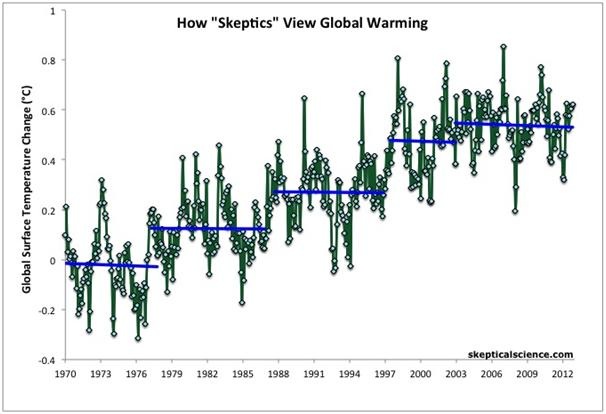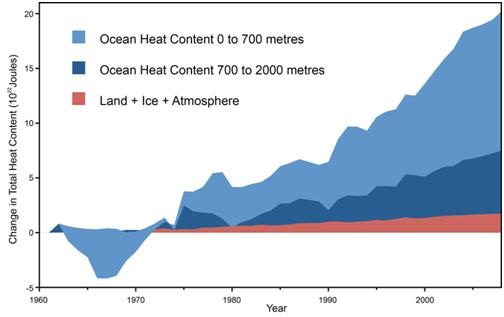400ppm history lesson for sceptic amateurs
On Thursday last week the US National Oceanic and Atmospheric Association’s daily average CO2 concentration figure exceeded 400 parts per million at its Hawaiian sampling station. Scientists estimate that the last time CO2 levels were so high was during the Pliocene – a geological era between three to five million years ago, prior to the evolution of humans.
It brought to mind the following reader comment on Climate Spectator:
Are people really still talking about this hoax?
After Sept 14, I predict that the whole carbon debate will go the same way as the Labor party and disappear off the radar.
Climate is changing, it always has done and always will do. Current changes are well within the parameters of past changes.
You’ve got to love it when deniers of global warming lead with their chin. Yes, he’s right that the world’s climate has undergone quite dramatic changes in the past.
Last time CO2 concentration levels were this high, climatologists estimate global average temperatures were around 3 to 4 degrees Celsius higher than today and as much as 10 degrees Celsius warmer at the poles. Sea level ranged between five and 40 metres higher.
What’s more, not only are we going to match the Pliocene CO2 levels, we’re on track to double them by the end of the century if we keep at the current emissions growth trajectory.
According to our learned website commenter though:
What we should be doing is accepting that the world is bigger than us rather than the other way around and we should be positioning ourselves to handle climate change when it does happen.
Instead of trying to reduce emissions via:
Carbon taxes, abatements, ETS, whatever you want to call them are political solutions, mostly of a socialist nature.
Here’s the problem though – the kind of change we are about to impose in the space of a century or two is akin to replicating rates of change that the fossil record suggests lead to mass extinctions of life. That is not the mental imaginings of some socialist, hippie philosopher, it’s embedded within rocks.
Such warnings from the geological record are rather sobering. Given this, maybe it’s time we took the advice of the bulk of professionals whose day job is studying the Earth’s climate and its influence on life.
This doesn’t mean the advice of a handful of specially selected scientists plucked out of obscurity by think tanks like the Institute of Public Affairs. No, I’m talking about weighing up the vast bulk evidence in the peer-reviewed scientific literature.
Because some people have difficulty with this one, let me illustrate with an example. Graham Lloyd of The Australian newspaper told us that according to “experts”, rather than being worried about global warming the decline of solar irradiance means we might be headed of a mini ice age. This is based on the opinion of “one of the world’s leading solar physicists, Habibullo Abdussamatov …Abdussamatov is the head of space research at the Russian Academy of Sciences Pulkovo Astronomical Observatory in St Petersburg, and director of the Russian segment of the International Space Station.”
Impressive stuff. But according to skepticalscience.com, which tracks the publishing record of climate sceptics, Abdussamatov has not one scientific journal article to his name supporting his claims. He also believes we should pretty much toss out our entire scientific understanding for why large parts of the Earth seem to retain warmth at night time when the sun isn’t shining. In a 2007 article published on Canada.com it reports:
“Dr Abdussamatov goes further, debunking the very notion of a greenhouse effect. "Ascribing 'greenhouse' effect properties to the Earth's atmosphere is not scientifically substantiated," he maintains. "Heated greenhouse gases, which become lighter as a result of expansion, ascend to the atmosphere only to give the absorbed heat away."
Do you want to bet your house on a person with such views?
As another example of how we should be informed by weight of professional opinion and evidence, let’s look at this claim that the world has stopped warming for the past 15 years.
As you may have noticed the weather and climate is pretty variable. So trying to isolate underlying trends from the noise typically requires taking a very comprehensive view over an extended period of time. Yet if you isolate sub- periods from the broader historical record you can come up with some convenient averaged blue lines showing temperature stabilising or declining.

Source: Skepticalscience.com
To explain further – have you ever noticed when you look at a picture of the planet that there’s a lot of blue stuff surrounding the land? The apparent temperature pause that non-professionals like Andrew Bolt get so excited about is based on land-based instrument records.
But to be comprehensive, ideally one also needs to look at changes to ocean temperature. During years with La Niña events, more heat is transferred to the oceans, and surface temperatures are relatively cool as a result. The opposite is true during El Niño years. During the 1990s, there were more El Niño than La Niña events, which resulted in more surface air warming. One of the strongest El Niño events of the century happened in 1998, which not coincidentally was 15 years ago.
The chart below, prepared by Dana Nuccitelli et al using ocean temperature records, illustrates how the vast bulk of extra energy has been transferred into the oceans rather than heating-up the land.

Land, atmosphere, and ice heating (red), 0-700 meter OHC increase (light blue), 700-2,000 meter OHC increase (dark blue). From Nuccitelli et al. (2012), and available from: http://skepticalscience.com/nuccitelli-et-al-2012.html
There are several highly talented mathematicians, known as climate attribution specialists, who spend their professional lives analysing the various potential drivers of global temperature. They look at solar irradiance, volcanic eruptions, pollutant aerosols, ocean mixing and a range of other items that have been used as red herrings by those that don’t like the idea of regulating carbon emissions. They look at all of these potential factors and have come to the opinion that CO2 and other greenhouse gases will significantly warm the planet. This is based on maths, not Marxist logic.
With CO2 concentrations breaking the 400ppm threshold, it is time we listened to professionals, instead of rank amateurs driven more by a phobia of socialism or commercial interests rather than genuine scientific scepticism.
















